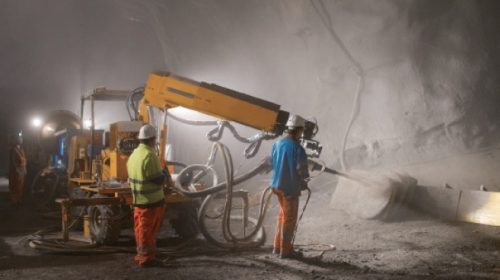Silica particles graded at nano-scale, where the unit of measure is 1 billionth meter, might be the smallest objects on admixture scientists’ radar, but are on the cusp of becoming one of the most important concrete developments since the mid-1990s advent of polycarboxylate superplasticizers.
A principal player in polycarboxylates, GCP Applied Technologies likewise recognizes the promise of nano-silica, whose performance in concrete owes to reactive surface area hovering 1,000 times that of portland cement or pozzolanic materials. The company’s charter nano-silica product, Tytro RC 430, is the newest of six agents in the Tytro Shotcrete System, geared to making underground construction processes faster and more economical against conventional methods and mix designs.
Non-porous, spherical, non-aggregated and dispersed in water free from chlorides and low alkali, Tytro RC rheology control modifier functions as a pozzolan and silica fume alternative. It is based on a synthetic colloidal silica suspension, highly reactive and of significantly greater fineness and purity (> 99.6 percent silicon dioxide) than silica fume, but safely handled like a traditional liquid admixture. Dosed at 0.5 to 1.5 percent by weight of total cementitious materials content, Tytro RC meets ASTM C494 Type S Specific Performance Admixtures specs.
In laboratory tests and field trials leading up to Tytro Shotcrete System commercialization, GCP staff found that the agent, when measured for net silicon dioxide content, could be used at a 1:10 ratio of silica fume and impart comparable or higher strength in finished surfaces or structures. The company formulates Tytro RC in multiple grades based on the surface area of silica fume it is replacing or supplementing; mix design plus steel or synthetic reinforcing fiber dosage; durability and early or later age strength development requirements; and, raw material quality and consistency.
Mine or tunnel contractors and engineers across the world have observed the agent’s cost effectiveness by labor and material consumption metrics. In wet-mix shotcrete, the nano-silica’s spontaneous binding capacity enables nozzlemen to reach a specified lining or cover thickness in fewer passes versus application of a conventional silica fume mix.
In a report for the journal Shotcrete, GCP Global R&D Director, Concrete Products Klaus-Alexander Rieder and R&D Division Concrete Scientist Ezgi Yurdakul review critical wet-mix shotcrete aspects: “Sprayability is the efficiency of a mixture at sticking to the applied surface (adhesion) and to itself (cohesion). Pumpability is the stability and mobility of a mixture under pressure. One of these two parameters is often compromised due to requiring conflicting properties.”
“When added to a wet-mix shotcrete, the RC agent significantly increases cohesiveness while reducing bleeding and segregation. Therefore, while also improving sprayability and pumpability characteristics, it reduces rebound and increases maximum thickness of buildup,” they affirm. “At sufficiently high addition rates, colloidal silica can accelerate the early-age hydration process of the shotcrete mixture, which reduces the time of setting and increases early-age strength compared to mixtures containing silica fume.”
SYSTEM CATALYST
|
|
| Shown here in an early field application, the Tytro Shotcrete System offers these GCP-cited benefits against silica fume alternatives: high dosage efficiency; enhanced sprayability and improved cohesion; waste minimization through lower rebound and dust; reduced cycle times owing to greater layer thickness attained in a single pass; accelerated strength development; lower permeability and higher water penetration resistance; handling ease and safety; more consistent quality; and, storage efficiency in the absence of silo requirements.PHOTO: GCP |
GCP displayed pilot-stage Tytro RC at the 2016 World of Concrete, and formally launched the agent with the Tytro Shotcrete System later that year. “The system provides improved agility and additional capabilities that applicators and global contractors have been demanding for decades,” observed GCP Specialty Construction Chemicals President Adam Grose. “Our technical specialists have analyzed the unique challenges of underground construction to create customized mix designs, delivering the most optimized and cost-efficient mix for each project.”
When measured against conventional mixes and operations, GCP notes, Tytro Shotcrete maintains low rebound rates of 5-8 percent; yields faster early strength and enhanced bonding-to-rock with an increased one-pass thickness build up; and, allows underground construction professionals to reduce operating costs and minimize excavation downtime without sacrificing performance or relaxing safety standards. The system also exhibits up to 10 percent lower installed cost, achieved through mix optimization, waste minimization and shorter cycle times; and, affords faster construction area re-entry times due to more rapid early age strength development at equal accelerator dosage rate.
Joining RC in the Tytro Shotcrete System are GCP’s Strux 2-in. synthetic macro-fiber plus these companion agents: WR high-range water reducer; HC hydration control, extending mix working life up to 72 hours; SA, an alkali-free set accelerator formulated to provide high early strength at low dosage rates; AE air entraining admixture; and, RM, a rheology modifier to improve pumpability and spraying sequences. — GCP Applied Technologies, Cambridge, Mass., www.gcpat.com/shotcrete



